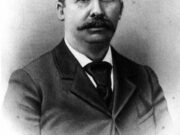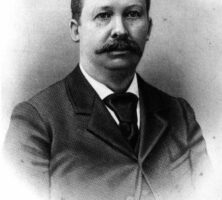One of the distinguishing features of southern culture is an “oratorical aesthetic.”
Speech artistry, expressed through delivery as well as content, can still be heard in Georgians’ political and legal oratory, preaching, and conversation. Central to the region’s love affair with the spoken word is a strong narrative impulse, channeled in the telling of elaborately embroidered personal experiences as well as traditional tales.
This thirst for a well-told story may be rooted in two influential Old World source areas for the South’s population, Ireland and Africa, where the institution of community storyteller (the sennachie and griot) commanded great respect. The insularity of the region’s farming population also put a premium on storytelling as entertainment. For many Georgians, oral literature in the form of folktales and legends took the place of novels and history books until the twentieth century brought greater access to literacy through public schools and libraries.
Video by Darby Carl Sanders, New Georgia Encyclopedia
Traditional storytelling took—and still takes—place wherever small groups have gathered to work and socialize. In rural Georgia such physical settings included general stores (with their “liars’ bench” out front), hunting camps, and the shaded porch and fireside of homes; social occasions involving storytelling included community “workings” such as corn shucking and syrup making, and, for southwest Georgians, annual family treks by covered wagon to the Florida coast to buy salted fish. Today, jokes are exchanged during office breaks and after work at bars; scary stories are told at slumber, or spend-the-night, parties and around Scout campfires; and urban legends circulate in beauty parlors, school cafeterias, and college fraternity and sorority suites.
Folklorists divide folk narratives into two main categories, based on the storytelling community’s attitudes. Folktales are those orally transmitted stories that are understood as fictitious; they function mainly as entertainment but also convey values. Myths and legends, on the other hand, are belief tales, regarded as true accounts of past events; they can be entertaining but principally serve to support the belief system and as folk history.
Native American Myths
More specifically, myths are defined as the sacred stories supporting a religion; they often explain the present order of things as the creation of divinities, who are the chief characters. In the United States, oral myths (as opposed to the literary mythology of the Bible) are found primarily among Native Americans. The Cherokees who once inhabited north Georgia maintain a living tradition of oral myths in western North Carolina. A good example is the creation story told by Lloyd Arneach, a Cherokee storyteller. A variation on the universal flood myth, it attributes the formation of the Cherokees’ mountainous homeland to a primeval buzzard that flapped his wings in the mud as he searched for dry land. Such myths have rarely figured in the Georgia storyteller’s repertoire since the Native American population was forcibly removed in the early nineteenth century.
Animal Tales
Stories with animal characters that behave like humans have come, with the popularity of Joel Chandler Harris’s Uncle Remus books of the 1880s, to exemplify Georgia folktales. Harris heard many of these African American tales, which feature the amoral trickster Brer Rabbit, in Putnam County; folklorist Florence Baer recently confirmed his belief in their strong West African roots. The most famous of the Brer Rabbit stories,”The Wonderful Tar-Baby Story,” is first documented in the South among the Cherokees of Oklahoma in 1845, thirty-two years before its earliest report in Black tradition. It is likely, however, that Southeastern Indians had borrowed it from African Americans.
Old Master and John Tales
Although seldom published, another important African American “cycle,” or group of related folktales, replaces the rabbit trickster with a human one, John, whose cunning sometimes allows him to get the upper hand on his enslaver (or, in a postbellum setting, boss). Humorous in tone, these stories nonetheless offer an insider’s perspective on slavery. The Alabama-born master storyteller Lee Drake used them to entertain fellow workers in Atlanta in the 1960s. One of his favorites, in which John and his enslaver are both portrayed as numskulls who mistake two thieves sharing their loot in a graveyard for the Lord and the Devil dividing souls on Judgment Day, is in fact one of the oldest English folktales still told in Georgia. Originally poking fun at the clergy, it is found in a sixth-century manuscript and Renaissance jest book and, after coming to the South, was adapted to fit the Master and John cycle.
Jack Tales
In the United States an oral tradition of English-language fairytales (or Märchen, as the Grimm brothers called this kind of story) is weak except in the upland South. A cycle featuring the clever young hero Jack is concentrated among the Ward, Harmon, and Hicks families of Beech Mountain, North Carolina, but also exists elsewhere in Appalachia, including north Georgia. Jack tales, with their centuries-old European roots, have been Americanized with features of mountain life. In one example told by Jimmy Blaylock of Dalton, Jack is a moonshiner who uses his wits to escape two revenue officers, convincing one to go to hell to find the world’s most beautiful girl.
Jests
With their humor deriving from characters, situation, or punch line, jests (or jokes) are intended to provoke laughter. They are the most prevalent type of folktale in Western society today. Older jests popular in Georgia include those dealing with marital strife (e.g., the “Taming of the Shrew” that was known to Shakespeare), preacher tales in which the respected minister is taken down a notch, and numskull tales featuring the misadventures of Irish immigrants Pat and Mike. Modern jests, often inspired by current events, include so-called dirty jokes that depend on their shock value.
Tall Tales
Relying on absurd exaggeration, tall tales, like jests, are humorous but are best told with a straight face. Many arose from the challenges of the American frontier and the physical conditions of each region. Lem Griffis (1896-1968), Georgia’s most famous traditional storyteller, specialized in this kind of narrative. His tales often were set in the Okefenokee Swamp, where he was a hunting and fishing guide. One such story features his uncle Paul, whose walking stick was struck by a swamp snake. The poison caused the stick to swell into a giant log, but instead of abandoning it, the enterprising old man had a sawmill moved to the site and cut the log into ten miles of railroad crossties. Still undaunted when a rainstorm washed the poison out of the ties and they shrank, he gathered them up and sold them for toothpicks.
Video by Darby Carl Sanders, New Georgia Encyclopdedia
Legends
Common subjects of Georgia legends include traumatic episodes in the state’s history, such as the Civil War (1861-65), encounters with ghosts and other supernatural phenomena, and modern anxieties like homicidal maniacs on the loose and contaminated consumer products.
Perhaps the state’s best-known local legend is set in the White County hills and features Cherokee princess Nacoochee and her lover from a rival tribe, Sautee. Pursued by her father’s braves, the eloping couple jump off Mount Yonah and are buried in the mound that is a prominent feature of the valley below. Though not an authentic Native American narrative, this typical lovers’ leap legend has achieved oral currency as an emblem of local identity. Nacoochee Valley resident George W. Williams was the greatest contributor to the Romeo and Juliet–inspired fabrication; his version was first published in 1871.
Conclusion
Georgia has played a major role in shaping the South’s reputation as a prime storytelling region. Older folk narratives are still being told alongside a crop of modern tales. Meanwhile, a revival of interest in live-audience narration has emerged, with Atlanta the home of an organization called the Southern Order of Storytellers. In their performances these professionals often use the older tales as a resource, giving them new life.






